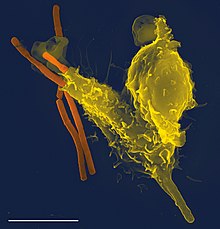ഫാഗോസൈറ്റ്

ഫാഗോസൈറ്റുകൾ Phagocytes നമ്മുടെ ശരീരത്തിലെത്തുന്ന അപകടകാരികളായ കണികകൾ, ബാക്ടീരിയ, മൃതമായതോ മരിച്ചുകൊണ്ടിരിക്കുന്നതുമായ കോശങ്ങൾ തുടങ്ങിയവയെ ആഹരിച്ചു നശിപ്പിച്ച് ശരീരത്തെ രക്ഷിക്കുന്നു. ഇവയുടെ പേര് ഗ്രീക്ക് പദമായ Greek phagein, "to eat" or "devour", and "-cyte", the suffix in biology denoting "cell", from the Greek kutos, "hollow vessel".[1] അവ ശരീരത്തിലുണ്ടാകുന്ന അണുബാധയേയും തുടർന്നു ലഭിക്കുന്ന രോഗപ്രതിരോധത്തിനും അത്യന്താപേക്ഷിതമാണ്.[2] ജന്തുലോകത്ത് ഫാഗോസൈറ്റുകൾ വളരെ പ്രാധാന്യമുള്ളതാണ്.[3] കശേരുകികളിൽ ഇത് വളരെയധികം വികസിച്ചിട്ടുണ്ട്.[4] ഒരു ലിറ്റർ മനുഷ്യരക്തത്തിൽ 6 ദശലക്ഷം ഫാഗോസിറ്റുകൾ ഉണ്ട്.[5] അവയെ 1882 ൽ ഇല്യ ഇലിയിച്ച് മെക്നിക്കോവ് ആണു കണ്ടുപിടിച്ചത്. നക്ഷമത്സ്യത്തിന്റെ ലാർവ്വയെ പഠിക്കുമ്പോൾ ആണിതു അദ്ദേഹം കണ്ടുപിടിച്ചത്.[6] 1908ൽ മെക്നിക്കോവിനു ഈ കണ്ടുപിടിത്തത്തിനു വൈദ്യശാസ്ത്രത്തിനുള്ള നോബൽ സമ്മാനം ലഭിച്ചു.[7] ഫാഗോസൈറ്റുകൾ അനേകം സ്പീഷീസുകളിൽ കാണപ്പെടുന്നുണ്ട്; ചില അമീബകൾ ഫാഗോസൈറ്റുകളുടെ മാക്രോഫേജിന്റെ സ്വഭാവം കാണിക്കുന്നുണ്ട്. ഇതു കാണിക്കുന്നത്, ജീവന്റെ പരിണാമഘട്ടത്തിന്റെ ആദ്യഘട്ടത്തിൽ ഫാഗോസൈറ്റുകൾ പ്രത്യക്ഷപ്പെട്ടു എന്നാണ്.[8]
ചരിത്രം
[തിരുത്തുക]ഫാഗോസൈറ്റോസിസ്
[തിരുത്തുക]
= കൊല്ലുന്നതിന്റെ രീതി
[തിരുത്തുക]അപ്പോപ്റ്റോസിസിൽ ഉള്ള പങ്കാളിത്തം
[തിരുത്തുക]
മറ്റു കോശങ്ങളുമായുള്ള വിനിമയം
[തിരുത്തുക]പ്രൊഫണൽ അല്ലാത്ത ഫാഗോസൈറ്റുകൾ
[തിരുത്തുക]Pathogen evasion and resistance
[തിരുത്തുക]അവലംബം
[തിരുത്തുക]- ↑ The Shorter Oxford English Dictionary. Oxford University Press (Guild Publishing). 1983. pp. 1566–67.
{{cite book}}: Unknown parameter|authors=ignored (help) - ↑ Delves et al. 2006, പുറങ്ങൾ. 2–10
- ↑ Delves et al. 2006, പുറം. 250
- ↑ Delves et al. 2006, പുറം. 251
- ↑ Hoffbrand, Pettit & Moss 2005, പുറം. 331
- ↑ Ilya Mechnikov, retrieved on November 28, 2008. From Nobel Lectures, Physiology or Medicine 1901–1921, Elsevier Publishing Company, Amsterdam, 1967. Archived August 22, 2008, at the Wayback Machine.
- ↑ Schmalstieg, FC; AS Goldman (2008). "Ilya Ilich Metchnikoff (1845–1915) and Paul Ehrlich (1854–1915): the centennial of the 1908 Nobel Prize in Physiology or Medicine". Journal of medical biography. 16 (2): 96–103. PMID 18463079.
- ↑ Janeway, Chapter: Evolution of the innate immune system. retrieved on March 20, 2009
